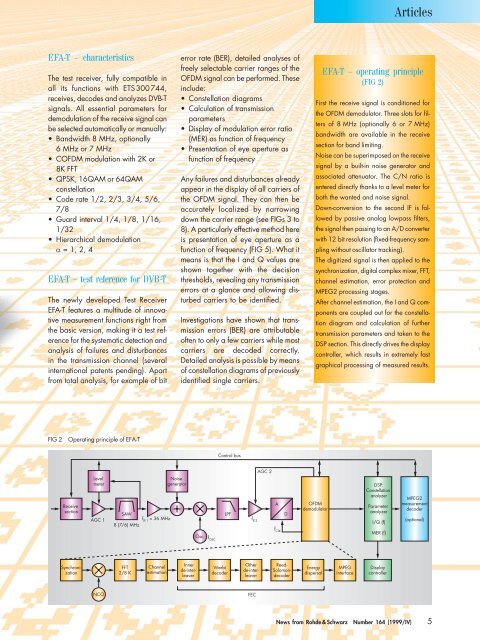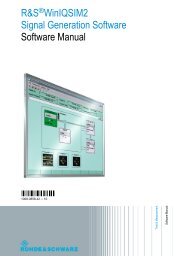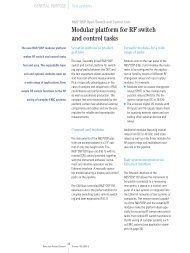News from Rohde&Schwarz - Rohde & Schwarz
News from Rohde&Schwarz - Rohde & Schwarz
News from Rohde&Schwarz - Rohde & Schwarz
You also want an ePaper? Increase the reach of your titles
YUMPU automatically turns print PDFs into web optimized ePapers that Google loves.
Articles<br />
EFA-T – characteristics<br />
The test receiver, fully compatible in<br />
all its functions with ETS300744,<br />
receives, decodes and analyzes DVB-T<br />
signals. All essential parameters for<br />
demodulation of the receive signal can<br />
be selected automatically or manually:<br />
• Bandwidth 8 MHz, optionally<br />
6 MHz or 7 MHz<br />
• COFDM modulation with 2K or<br />
8K FFT<br />
• QPSK, 16QAM or 64QAM<br />
constellation<br />
• Code rate 1/2, 2/3, 3/4, 5/6,<br />
7/8<br />
• Guard interval 1/4, 1/8, 1/16,<br />
1/32<br />
• Hierarchical demodulation<br />
= = 1, 2, 4<br />
EFA-T – test reference for DVB-T<br />
The newly developed Test Receiver<br />
EFA-T features a multitude of innovative<br />
measurement functions right <strong>from</strong><br />
the basic version, making it a test reference<br />
for the systematic detection and<br />
analysis of failures and disturbances<br />
in the transmission channel (several<br />
international patents pending). Apart<br />
<strong>from</strong> total analysis, for example of bit<br />
error rate (BER), detailed analyses of<br />
freely selectable carrier ranges of the<br />
OFDM signal can be performed. These<br />
include:<br />
• Constellation diagrams<br />
• Calculation of transmission<br />
parameters<br />
• Display of modulation error ratio<br />
(MER) as function of frequency<br />
• Presentation of eye aperture as<br />
function of frequency<br />
Any failures and disturbances already<br />
appear in the display of all carriers of<br />
the OFDM signal. They can then be<br />
accurately localized by narrowing<br />
down the carrier range (see FIGs 3 to<br />
8). A particularly effective method here<br />
is presentation of eye aperture as a<br />
function of frequency (FIG 5). What it<br />
means is that the I and Q values are<br />
shown together with the decision<br />
thresholds, revealing any transmission<br />
errors at a glance and allowing disturbed<br />
carriers to be identified.<br />
Investigations have shown that transmission<br />
errors (BER) are attributable<br />
often to only a few carriers while most<br />
carriers are decoded correctly.<br />
Detailed analysis is possible by means<br />
of constellation diagrams of previously<br />
identified single carriers.<br />
EFA-T – operating principle<br />
(FIG 2)<br />
First the receive signal is conditioned for<br />
the OFDM demodulator. Three slots for filters<br />
of 8 MHz (optionally 6 or 7 MHz)<br />
bandwidth are available in the receive<br />
section for band limiting.<br />
Noise can be superimposed on the receive<br />
signal by a built-in noise generator and<br />
associated attenuator. The C/N ratio is<br />
entered directly thanks to a level meter for<br />
both the wanted and noise signal.<br />
Down-conversion to the second IF is followed<br />
by passive analog lowpass filters,<br />
the signal then passing to an A/D converter<br />
with 12 bit resolution (fixed-frequency sampling<br />
without oscillator tracking).<br />
The digitized signal is then applied to the<br />
synchronization, digital complex mixer, FFT,<br />
channel estimation, error protection and<br />
MPEG2 processing stages.<br />
After channel estimation, the I and Q components<br />
are coupled out for the constellation<br />
diagram and calculation of further<br />
transmission parameters and taken to the<br />
DSP section. This directly drives the display<br />
controller, which results in extremely fast<br />
graphical processing of measured results.<br />
FIG 2<br />
Operating principle of EFA-T<br />
Control bus<br />
Receive<br />
section<br />
Level<br />
meter<br />
AGC 1<br />
SAW<br />
f IF,1 = 36 MHz<br />
8 (7/6) MHz<br />
Noise<br />
generator<br />
LPF<br />
AGC 2<br />
f IF,2<br />
A<br />
D<br />
OFDM<br />
demodulator<br />
DSP:<br />
Constellation<br />
analyzer<br />
Parameter<br />
analyzer<br />
I/Q (f)<br />
MPEG2<br />
measurement<br />
decoder<br />
(optional)<br />
Osc.<br />
f OSC<br />
f CLK<br />
MER (f)<br />
FFT<br />
2/8 K<br />
Channel<br />
estimation<br />
Inner<br />
de-interleaver<br />
Viterbi<br />
decoder<br />
Other<br />
de-interleaver<br />
Synchronization<br />
Reed-<br />
Solomondecoder<br />
Energy<br />
dispersal<br />
MPEG<br />
interface<br />
Display<br />
controller<br />
NCO<br />
FEC<br />
<strong>News</strong> <strong>from</strong> <strong>Rohde</strong> & <strong>Schwarz</strong> Number 164 (1999/IV) 5

















